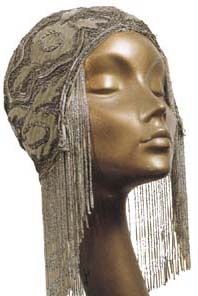 |
 |
 A 1920's head-dress with beaded fringe
|
Costumes and Textiles -
The collection of costumes and textiles dates from around 1600 to the present day and includes some fine examples of seventeenth-century embroidery and eighteenth-century embroidered waistcoats as well as a great variety of nineteenth century women's and children's wear.
The collection specialises in fine embroideries and costume with ornate surface decoration. The seventeenth-century examples include sleeve-panels with fashionable strawberry designs in red silks and gold thread. An elaborate man's cap and a lady's coif are decorated with Tudor rose and other floral motifs, while a frame picture of the same period has the classical figure of Charitas, surrounded by similar creatures created in numerous exquisitely detailed embroidery techniques.
To this was added in 1993 the Irene Barnes Collection of women's beaded and sequined costumes, from c.1919 to 1939, which includes costumes and accessories of the period as well as provincial, court and wedding attire. The emphasis is on the glamorous evening wear that epitomises the high fashion styles of the Jazz Age. This particular vogue was influenced by Paris designers, especially 'Coco' Chanel, one of the outstanding talents of the 1920s, who introduced the new, straight, tubular look. Although cut in simple shapes, these dresses were extravagantly decorated with embroidery, beads and sequins; this surface decoration was influenced by Leon Bakst's Arabian designs for Diaghilev's Ballets Russes, who performed in Paris in 1909.
The introduction of tambour 'beading' into the Paris fashion houses in the early 1920s enabled the beads and sequins to be applied much faster than was possible by hand. This led to a marked increase in lavishly decorated evening wear. At the same time, trade embroidery machines were becoming available. The versatile Cornely machine produced chain-stitch, cording and ribbon work; the Irish '107' produced an even satin stitch with variation in length, and the Schiffli multi-needled machine was able to simulate lace and embroidery. Examples of all these types of embroidery and beading are represented in the collection.
There were originally few examples of nineteenth-century costume in the museum, with the exception of a lovely 1865-8 ball gown made from pineapple fibre and elaborately trimmed with lace, ribbon and velvet and an earlier printed cotton maternity dress. However, over the last few years the museum has acquired many splendid examples of ladies' Victorian costume. These include two printed cotton dressed from the 1840s; a brown, embroidered silk two-piece maternity dress c. 1850; a sprigged muslin bustle dress from c. 1870 and an amazing 1870s dress that is heavily embroidered with beetles' wings. There is also an extensive collection of underwear from the Victorian period onwards.
The textile department undertakes an extensive programme of workshops and study sessions.
|
| Go to Museums Homepage | Updated 17 August 2009 | Go to Home Page |